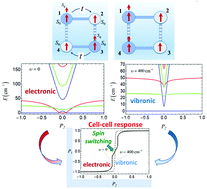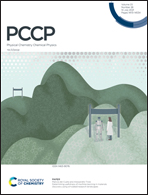Toward multifunctional molecular cells for quantum cellular automata: exploitation of interconnected charge and spin degrees of freedom
Abstract
We discuss the possibility of using mixed-valence (MV) dimers comprising paramagnetic metal ions as molecular cells for quantum cellular automata (QCA). Thus, we propose to combine the underlying idea behind the functionality of QCA of using the charge distributions to encode binary information with the additional functional options provided by the spin degrees of freedom. The multifunctional (“smart”) cell is supposed to consist of multielectron MV dn–dn+1-type (1 ≤ n ≤ 8) dimers of transition metal ions as building blocks for composing bi-dimeric square planar cells for QCA. The theoretical model of such a cell involves the double exchange (DE), Heisenberg–Dirac–Van Vleck (HDVV) exchange, Coulomb repulsion between the two excess electrons belonging to different dimeric half-cells and also the vibronic coupling. Consideration is focused on the topical case in which the difference in Coulomb energies of the two excess electrons occupying nearest neighboring and distant positions significantly exceeds both the electron transfer integral and the vibronic energy. In this case the ground spin-state of the isolated square cell is shown to be the result of competition of the second-order DE producing a ferromagnetic effect and the HDVV exchange that is assumed to be antiferromagnetic. In order to reveal the functionality of the magnetic cells, the cell–cell response function is studied within the developed model. The interaction of the working cell with the polarized driver-cell is shown to produce an antiferromagnetic effect tending to suppress the ferromagnetic second-order DE. As a result, under some conditions the electric field of the driver cell is shown to force the working cell to exhibit spin-switching from the state with maximum dimeric spin values to that having minimal spin values.

- This article is part of the themed collection: Quantum Computing and Quantum Information Storage


 Please wait while we load your content...
Please wait while we load your content...